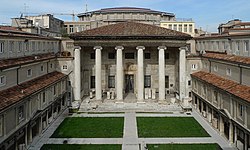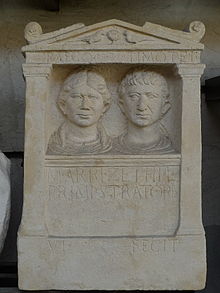Museo Lapidario Maffeiano
 Lobby of the Philharmonic |
|
| Data | |
|---|---|
| place | Piazza Bra, Verona |
| Art |
Archaeological Museum
|
| opening | 18th century |
| operator |
Verona municipality
|
| Website | |
The Museo Lapidario Maffeiano in Verona is one of the oldest archaeological museums in Europe. It shows Etruscan , Greek and Roman finds.
history

The Museo Lapidario Maffeiano is located near Piazza Bra, within the ancient city walls of Verona. The forerunner of today's museum is a collection of 28 inscriptions . They were placed in the vestibule of the Philharmonic Academy built in 1612.
The museum was realized in the first half of the 18th century after the project for a "Museo Lapidario" in Verona was created in 1716. It was realized by the Veronese writer Scipione Maffei , who presented his collection of Greek, Etruscan, Roman and early Venetian inscriptions, reliefs, urns, sarcophagi and sculptures there. A first version of the exhibition was prepared between 1718 and 1727. Maffei had a wall that surrounded the courtyard of the Philharmonic Academy covered with a small weather roof. 230 inscriptions were walled in there. This first exhibition was revised in the following years and brought to a conclusion in 1745. A colonnade was built around the courtyard of the Philharmonic Academy for the museum. Maffei's planning for the museum went even further. For example, the “Porta dei Leoni” should be set up in front of the museum entrance in the middle of the garden. The garden should be turned into a botanical garden. Maffei himself continued to work in the museum until 1754, a year before his death, adding two Greek reliefs and three Latin inscriptions.
In 1797, after the fall of the Republic of Venice under Napoleon , the museum was looted. Most of the pieces were returned later, but some remained in the Louvre . In 1882 the city of Verona took over the museum. In 1927 the museum was rebuilt for financial reasons. It was reduced in size, many inscriptions were moved to the museum in Castelvecchio . At the end of the Second World War, the block of the Philharmonic Academy was damaged, the museum and the academy remained intact. During the reconstruction of the damaged parts of the building, the museum was closed until 1965. The reconstruction provided for doubling the height of the external structure of the building complex. In the 1970s, the museum was rebuilt and reopened in 1981.
The exhibition
Access to the museum is through an entrance building from Piazza Bra. From there the courtyard, colonnade and vestibule and the closed rooms of the museum can be reached via an elevator. A focus of the exhibition in the museum rooms are steles and urns . The ancient inscriptions and reliefs in the courtyard, in the colonnade and in the vestibule are arranged chronologically.
Exhibits in the museum rooms
Greek grave stele of Martha, daughter of Demosthenes, who died of an incurable disease at the age of 22 (2nd – 1st century BC) - from Rinia
Greek grave stele of Gaios Silios Bathyllos - a dog lies at his feet, two masks can be seen in the background, which indicate that the deceased was an actor (1st century AD) - from Attica
Roman sarcophagus with a relief showing the story of Phaeton's fall (1st century AD) - from Rome
Greek stone relief with two female figures - possibly nymphs (3rd – 4th century AD) - unknown site
Bas-relief. Photo by Paolo Monti , 1972






